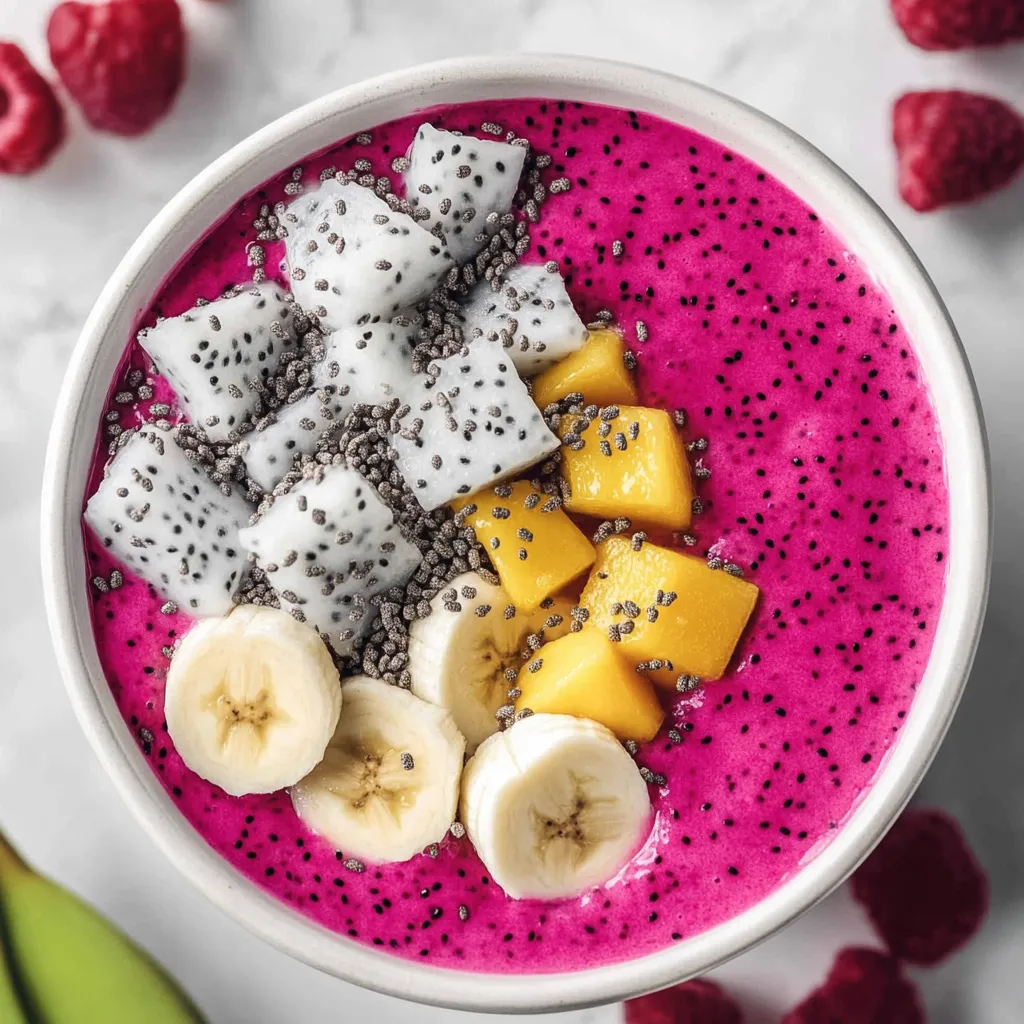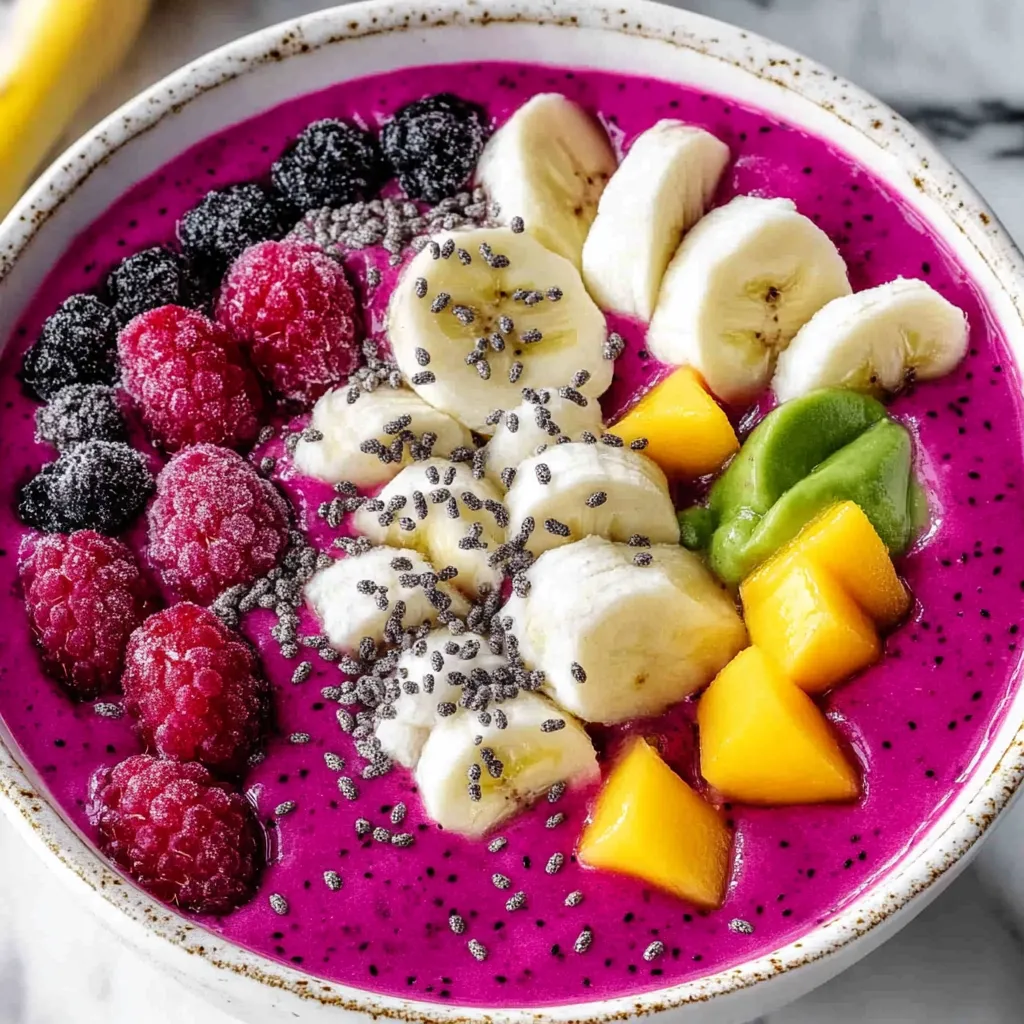 Pin it
Pin it
This dragon fruit smoothie bowl transforms an exotic, Instagram-worthy ingredient into a creamy, spoon-able breakfast that tastes like vacation in a bowl. The stunning fuchsia color comes naturally from red-flesh dragon fruit (also called pitaya), while frozen banana and mango create that perfect soft-serve texture that makes smoothie bowls so satisfying. Despite dragon fruit's exotic appearance and mystique, its mild flavor lets the tropical sweetness of mango and the subtle tartness of raspberries shine through, creating a breakfast that's as beautiful as it is delicious.
I'll admit I was initially intimidated by dragon fruit when I first spotted those alien-looking scaled fruits at the grocery store. But after trying my first pitaya bowl at a trendy juice bar and falling in love with both the taste and that gorgeous color, I knew I had to master making them at home. The first time I served these to my family, my daughter literally squealed with excitement over the "pink ice cream for breakfast" - and I loved that she was getting a powerhouse of nutrition while thinking she was having dessert.
Essential Ingredients and Selection Tips
- Frozen dragon fruit packets: Look for red-flesh varieties (not white) in the freezer section; brands like Pitaya Plus or Sambazon work beautifully
- Ripe frozen banana: Choose bananas with plenty of brown spots before freezing for maximum sweetness and creaminess
- Frozen mango chunks: These add tropical sweetness and help achieve that thick, scoopable texture; choose bright yellow pieces
- Frozen raspberries: These deepen the pink color while adding antioxidants and a subtle tartness that balances the sweetness
- Plant-based milk: Coconut milk enhances the tropical flavor, while almond milk keeps it lighter; use minimal amounts for thick consistency
Understanding Dragon Fruit
Dragon fruit might look intimidating with its scaly pink exterior, but it's actually one of the mildest tropical fruits you'll encounter. The flavor is often described as a cross between kiwi and pear - subtle, refreshing, and slightly sweet without being overpowering. This makes it perfect for smoothie bowls because it provides that stunning color and nutritional benefits without competing with other flavors.
The key to getting that gorgeous fuchsia color is using red-flesh dragon fruit rather than the white-flesh variety. While both types are nutritionally similar, the red flesh contains natural pigments called betalains (the same compounds that make beets red) which create that Instagram-worthy hue that makes this smoothie bowl so special. If you can only find white-flesh dragon fruit, your smoothie will still taste delicious but will have a more muted pink color.
Detailed Step-by-Step Instructions
- Prepare your frozen fruit arsenal:
- Remove one frozen dragon fruit packet (usually about 3.5 ounces), half a frozen banana, 1/3 cup frozen mango chunks, and 1/4 cup frozen raspberries from the freezer. Let them sit at room temperature for just 2-3 minutes to soften slightly - this makes blending easier while maintaining that thick, ice cream-like consistency. Have 1/4 cup of plant-based milk measured and ready to add gradually.
- Layer ingredients strategically in your blender:
- Add the liquid first (plant-based milk), followed by the softest frozen fruit (banana), then the harder pieces (mango and dragon fruit), and finally the raspberries on top. This layering helps everything blend more evenly and reduces strain on your blender motor. If you're using a regular blender rather than a high-speed one, consider chopping the frozen fruit into smaller pieces before adding.
- Master the blending technique:
- Start blending on low speed for 15-20 seconds to break up the largest pieces, then gradually increase to high speed. Use your tamper if you have one, or stop frequently to scrape down the sides and push fruit toward the blades. The goal is a completely smooth, thick consistency similar to soft-serve ice cream - this usually takes 60-90 seconds of total blending time. Add more milk only if absolutely necessary, one tablespoon at a time.
- Achieve the perfect texture:
- The finished smoothie should be thick enough that a spoon can stand upright in it for several seconds. If it's too thick and your blender is struggling, add plant-based milk one tablespoon at a time. If it becomes too thin, add more frozen fruit or place the entire blender jar in the freezer for 10 minutes to firm it back up. The texture should be uniform with no icy chunks remaining.
- Serve with style and speed:
- Quickly transfer the smoothie to a chilled bowl using a large spoon or ice cream scoop, creating attractive swirls or mounds. Work fast since the mixture will start to soften once it's out of the blender. Add your toppings immediately while the base is still firm enough to support them without sinking in.
 Pin it
Pin it
The nutritional profile of this smoothie bowl makes it feel like you're having dessert for breakfast while actually fueling your body with incredible nutrients. Dragon fruit is low in calories but high in vitamin C, magnesium, and iron, while also providing fiber that helps keep you satisfied. The combination of fruits provides natural sugars for energy, antioxidants for cellular protection, and fiber to help maintain steady blood sugar levels throughout the morning.
Topping selection can make or break a smoothie bowl experience, both visually and texturally. The contrast between the smooth, cold base and crunchy toppings is what makes eating these bowls so satisfying. I love arranging fresh kiwi slices, coconut flakes, and granola in distinct sections for that perfect Instagram shot, but more importantly, each topping adds different flavors and textures that keep every bite interesting.
The exotic factor of dragon fruit makes this smoothie bowl feel special and luxurious, even though it's surprisingly simple to make. There's something magical about transforming that unusual-looking fruit into something so beautiful and delicious - it's a great conversation starter and a fun way to introduce kids (and adults) to new ingredients without any intimidation factor.
Customization possibilities make this base recipe endlessly adaptable to different tastes and nutritional goals. Adding a scoop of vanilla protein powder transforms it into a post-workout recovery meal, while a squeeze of fresh lime juice brightens all the flavors and adds extra vitamin C. Sometimes I'll blend in a handful of spinach for extra nutrients - the strong pink color completely masks the green, making it perfect for sneaking vegetables into kids' breakfasts.
The social media appeal of dragon fruit smoothie bowls has made them a favorite for special occasions and weekend brunches, but their simplicity and nutrition make them practical for everyday eating too. This recipe bridges the gap between indulgent treat and healthy breakfast, proving that nutritious food can be every bit as exciting and satisfying as traditional breakfast pastries or sugary cereals. It's become my go-to recommendation for anyone who thinks healthy eating has to be boring or complicated - one look at that gorgeous pink color and creamy texture, and they're immediately converted to the idea that nutritious food can be absolutely stunning.
Frequently Asked Questions
- → What does dragon fruit taste like?
- Dragon fruit has a mild, sweet flavor that's similar to kiwi but less tart. It's refreshing and pairs well with other tropical fruits.
- → Can I use fresh dragon fruit instead of frozen?
- Yes! Use about half a cup of fresh dragon fruit, but you might need to add more ice to get that thick smoothie bowl texture.
- → Where can I buy dragon fruit packets?
- Most grocery stores carry frozen dragon fruit packets in the frozen fruit section. Look for brands like Pitaya Foods or Sambazon.
- → What toppings work best on this smoothie bowl?
- Try granola, coconut flakes, fresh berries, sliced banana, chia seeds, or nuts. Pick whatever you love!
- → How thick should the smoothie be?
- It should be thick enough to eat with a spoon, like soft serve ice cream. Add less milk if it's too thin.
- → Can kids eat this smoothie bowl?
- Absolutely! Kids love the bright pink color and sweet taste. It's a fun way to get them to eat more fruit.
